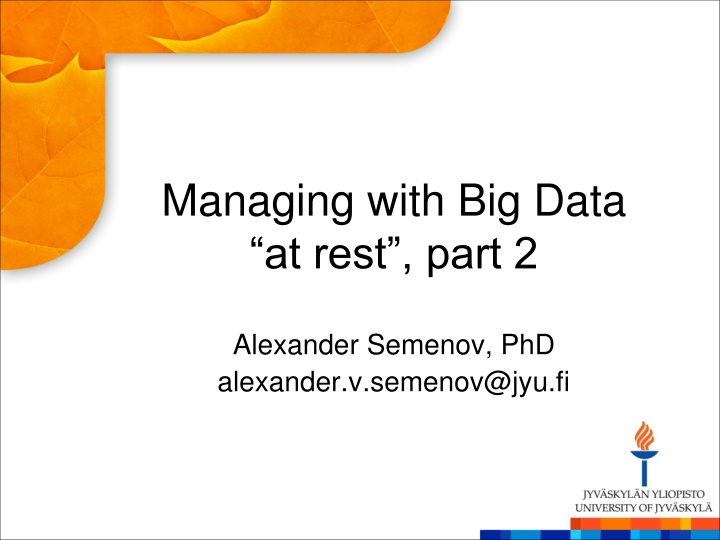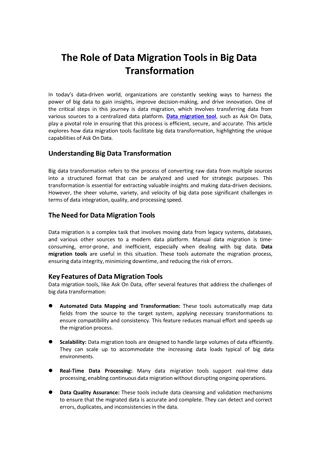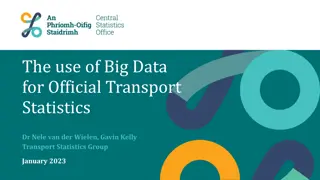
MongoDB: A Comprehensive Guide
Explore the world of MongoDB with Dr. Alexander Semenov in this detailed guide covering key features, usage, and hands-on examples. Discover how MongoDB excels as a cross-platform document-oriented database with high performance and scalability.
Download Presentation

Please find below an Image/Link to download the presentation.
The content on the website is provided AS IS for your information and personal use only. It may not be sold, licensed, or shared on other websites without obtaining consent from the author. If you encounter any issues during the download, it is possible that the publisher has removed the file from their server.
You are allowed to download the files provided on this website for personal or commercial use, subject to the condition that they are used lawfully. All files are the property of their respective owners.
The content on the website is provided AS IS for your information and personal use only. It may not be sold, licensed, or shared on other websites without obtaining consent from the author.
E N D
Presentation Transcript
Managing with Big Data at rest , part 2 Alexander Semenov, PhD alexander.v.semenov@jyu.fi
ToC 11.11.2015: MongoDB, CouchDB Parallel computing introduction MapReduce introduction Hadoop 12.11.2015 HDFS, HBase, PIG, Hive Apache Spark Stream processing Apace Storm
MongoDB cross-platform document-oriented database Stores documents , data structures composed of field and value pairs From http://www.mongodb.org/ Key features: high performance, high availability, automatic scaling, supports server-side JavaScript execution Has interfaces for many programming languages https://www.mongodb.org/
MongoDB > use mongotest switched to db mongotest > > j = { name : "mongo" } { "name" : "mongo" } > j { "name" : "mongo" } > db.testData.insert( j ) WriteResult({ "nInserted" : 1 }) > > db.testData.find(); { "_id" : ObjectId("546d16f014c7cc427d660a7a"), "name" : "mongo" } > > > k = { x : 3 } { "x" : 3 } > show collections system.indexes testData > db.testData.findOne()
MongoDB > db.testData.find( { x : 18 } ) > db.testData.find( { x : 3 } ) > db.testData.find( { x : 3 } ) > db.testData.find( ) { "_id" : ObjectId("546d16f014c7cc427d660a7a"), "name" : "mongo" } > > db.testData.insert( k ) WriteResult({ "nInserted" : 1 }) > db.testData.find( { x : 3 } ) { "_id" : ObjectId("546d174714c7cc427d660a7b"), "x" : 3 } > > var c = db.testData.find( { x : 3 } ) > c { "_id" : ObjectId("546d174714c7cc427d660a7b"), "x" : 3 }
MongoDB db.testData.find().limit(3) db.testData.find( { x : {$gt:2} } ) > for(var i = 0; i < 100; i++){db.testData.insert({"x":i});} WriteResult({ "nInserted" : 1 }) > db.testData.find( { x : {$gt:2} } ) { "_id" : ObjectId("546d174714c7cc427d660a7b"), "x" : 3 } { "_id" : ObjectId("546d191514c7cc427d660a7f"), "x" : 3 } { "_id" : ObjectId("546d191514c7cc427d660a80"), "x" : 4 } { "_id" : ObjectId("546d191514c7cc427d660a81"), "x" : 5 } { "_id" : ObjectId("546d191514c7cc427d660a82"), "x" : 6 } > db.testData.ensureIndex( { x: 1 } )
MongoDB vs SQL https://docs.mongodb.org/manual/reference/s ql-comparison/
Example: CouchDB, http://couchdb.org Open source document-oriented database written mostly in the Erlang programming language Development started in 2005 In February 2008, it became an Apache Incubator project and the license was changed to the Apache License rather than the GPL Stores collection of JSON documents Provides RESTFul API Query ability is allowed via views: Map and reduce functions
Example: CouchDB When a view is queried, CouchDB takes the code of view and runs it on every document from the DB View produces view result Map function: Written in JavaScript Has single parameter document Can refer to document s fields
curl -X PUT http://127.0.0.1:5984/albums/6e1295ed6c29495e54cc05947f18c8af -d '{"title":"There is Nothing Left to Lose","artist":"Foo Fighters"}'
Example: CouchDB "_id":"biking", "_rev":"AE19EBC7654", "title":"Biking", "body":"My biggest hobby is mountainbiking. The other day...", "date":"2009/01/30 18:04:11" } { "_id":"bought-a-cat", "_rev":"4A3BBEE711", "title":"Bought a Cat", "body":"I went to the the pet store earlier and brought home a little kitty...", "date":"2009/02/17 21:13:39" } { "_id":"hello-world", "_rev":"43FBA4E7AB", "title":"Hello World", "body":"Well hello and welcome to my new blog...", "date":"2009/01/15 15:52:20" }
CouchDB: Example View, Map function: function(doc) { if(doc.date && doc.title) { emit(doc.date, doc.title); } }
CouchDB: Example Map result is stored in B-tree Reduce function operate on the sorted rows emitted by map function Reduce function is applied to every leaf of B- tree function(keys, values, reduce) { return sum(values); }
CouchDB vs SQL http://guide.couchdb.org/draft/cookbook.html
Conclusions PostgreSQL: Fixed schema, SQL query language. Database has different tables with data MongoDB: stores JSON data, database has different collections, which store JSON documents CouchDB: stores JSON data, database contains documents; view functions define the queries
Parallel computing With horizontal scaling (scaling out) the processing is carried out on several computers same time Parallel computing is a form of computation in which many calculations are carried out simultaneously Large problems may be decomposed into smaller ones Parallel computer programs are more difficult to write than sequential ones Some algorithms can not be parallelized Synchronization should be taken into account increasing the degree of parallelization also increases communication costs
Parallel computing Bit level parallelism Increasing processor word size, which reduces number of instructions that processor should perform in order to process variables that did not fit into a word earlier: 8 bit, 16 bit, 32 bit, 64 bit Instruction level parallelism Several instructions may execute on one processor in parallel (if they are not dependent on each other) Performed inside the processor Example: sum and multiplications operations a = x*y b = j + k
Parallel computing Data parallelism Each processor performs same task on different parts of the data data = [1,2,3,4]; if (proc == 1) { process(data[0:2]); } else if (proc == 2) { process(data[2:4]); } Task parallelism Each processor executes its own task
Parallel computing vs Distributed computing Parallel computing: Typically, all processors or cores have access to the same shared memory Multi core, symmetric multiprocessing Distributed computing: Each processor has its own memory Interconnected by a network Communication costs are much higher, involves coordination
20 Speedup Speedup measures increase in running time due to parallelism. Based on running times, S(n) = ts/tp , where n denotes number of CPUs ts is the execution time on a single processor, using the fastest known sequential algorithm tp is the execution time using a parallel processor. For theoretical analysis, S(n) = ts/tpwhere tsis the worst case running time for of the fastest known sequential algorithm for the problem tp is the worst case running time of the parallel algorithm using n PEs.
Speedup Sequential execution time Speedup= Parallel execution time Maximum speedup is equal to n (number of CPU) Superlinear speedup is also possible Parallel system may have extra memory Usually, the best speedup possible for most applications is much smaller than n Usually some parts of programs are sequential and allow only one CPU to be active. Sometimes a large number of processors are idle for certain portions of the program. During parts of the execution, many CPUs may be waiting to receive or to send data. E.g., blocking can occur in message passing
Speedup Speedup ideal Super-linear Saturation Disaster Number of processors
Amdahl's law The speedup of a program using multiple processors in parallel computing is limited by the time needed for the sequential fraction of the program Let f be the fraction of operations in a computation that must be performed sequentially, where 0 f 1. The maximum speedup achievable by a parallel computer with n processors is 1 ) ( + 1 S n 1 ( / ) f f n f
Amdahl's law Amdahl's Law approximately suggests: Suppose a car is traveling between two cities 60 miles apart, and has already spent one hour traveling half the distance at 30 mph. No matter how fast you drive the last half, it is impossible to achieve 90 mph average before reaching the second city. Since it has already taken you 1 hour and you only have a distance of 60 miles total; going infinitely fast you would only achieve 60 mph.
25 Example 1 50% of a program s have to be executed sequentially. What is the maximum possible speedup? ) ( n S 1 5 . 0 2 ( ) S n Basic idea: when n -> infinity, 50% will still be sequential, while remaining 50% (parallel part) would be executed in time -> 0 Thus, it will be twice faster
26 Example 2 95% of a program s execution time occurs inside a loop that can be executed in parallel. What is the maximum speedup we should expect from a parallel version of the program executing on 8 CPUs? 1 ) 8 ( S 9 . 5 + . 0 05 1 ( . 0 05 / ) 8
Parallelizability Inherently serial problems are those problems which can not be parallelized Computations depend on each other Embarrassingly parallel problems can be easily decomposed into parallel tasks No communication is required between the parts
Example: OpenMP Open Multi-Processing Library, that adds multiprocessing support to C, C++, and Fortran http://openmp.org/ C++ version: Offers sets of preprocessor directives Program should be compiled with OpenMP support
OpenMP int main(int argc, char *argv[]) { const int N = 100000; int i, a[N]; #pragma omp parallel for for (i = 0; i < N; i++) a[i] = 2 * i; return 0; }
OpenMP #include <iostream> using namespace std; int main() { #pragma omp parallel { cout<<"Hello"<<endl; } return 0; }
Synchronization When parallel program is being developed, typically programmer should care about synchronization Otherwise the same data may be rewritten by parallel sections, etc There are many mechanisms Locks Critical sections Mutexes etc
OpenMP #include <iostream> using namespace std; int main() { #pragma omp parallel { #pragma omp critical cout<<"Hello"<<endl; } return 0; }
MapReduce MapReduce is a programming model and an associated implementation for processing and generating large data sets (From Jeffrey Dean and Sanjay Ghemawat, 2004) Inspired by the map and reduce primitives present in functional languages map and fold MapReduce was developed by Google, described in a paper MapReduce: Simplified Data Processing on Large Clusters Allows programmers without any experience with parallel and distributed systems to easily utilize the resources of a large distributed system
Map and fold map takes a function f and applies it to every element in a list Map takes single argument fold iteratively applies a function g to aggregate results Fold takes two arguments (first one may be 0), the second is a list Sum of squares x^2 + y^2 + + z^2 Map takes one parameter and squares it Fold gets the list iteratively sums them up
Map and Fold http://lintool.github.io/MapReduceAlgorithm s/index.html
MapReduce Users specify a map and a reduce functions map function processes a key/value pair to generate a set of intermediate key/value pairs Shuffle and sort step: Groups data by key, orders the values reduce function merges all intermediate values associated with the same intermediate key Values are in sorted order programs written in this style are automatically parallelized and executed by a run time system
MapReduce The run-time system handles partitioning the input data scheduling the program's execution across a set of machines handling machine failures managing the required inter-machine communication. There are many implementations, one of the most popular is Apache Hadoop
MapReduce example function map(String name, String document): // name: document name // document: document contents for each word w in document: emit (w, 1) function reduce(String word, Iterator partialCounts): // word: a word // partialCounts: a list of aggregated partial counts sum = 0 for each pc in partialCounts: sum += ParseInt(pc) emit (word, sum)
MapReduce example 1, word count Input: Hello World Bye World Hello Hadoop Goodbye Hadoop map: < Hello, 1> < World, 1> < Bye, 1> < World, 1> < Hello, 1> < Hadoop, 1> < Goodbye, 1> < Hadoop, 1> Shuffle: <Hello, [1,1]> <World, [1, 1]> <Bye, [1]> <Hadoop, [1,1]> <Goodbye, [1]> Reduce: < Bye, 1> < Goodbye, 1> < Hadoop, 2> < Hello, 2> < World, 2>
MapReduce, example 2 http://lintool.github.io/MapReduceAlgorithm s/index.html
(From Jeffrey Dean and Sanjay Ghemawat, 2004)
Combiners Word count emits a key-value pair for each word in the collection all these key-value pairs need to be copied across the network the amount of intermediate data will be larger than the input collection itself Solution is to perform local aggregation on the output of each mapper to compute a local count for a word over all the documents processed by the mapper Combiner is an optimization in MapReduce that allows for local aggregation before the shuffle and sort phase Might be viewed as mini-reducer Reducer may be used as a combiner only if it is associative and commutative In word count example reducer can be used as a combiner due to associativity and commutativity: A+B+C = A + (B+C) A+B = B + A
Partitioners Partitioners are responsible for dividing up the intermediate key space and assigning intermediate key-value pairs to reducers May help to handle imbalance in the amount of data associated with each key So that each reducer would have equal number of keys
Combiners http://lintool.github.io/MapReduceAlgorithm s/MapReduce-book-final.pdf
Combiner example basic MapReduce algorithm that computes the mean of values associated with the same key 1) MapReduce for mean computation (without combiner) From http://lintool.github.io/MapReduceAlgorithms/index.html
Combiner example In mean computation, reducer cannot be used as a combiner, since
From http://lintool.github.io/MapReduceAlgorithms/index.html
MapReduce applications Count of URL Access Frequency: The map function processes logs of web page requests and outputs <URL, 1>. The reduce function adds together all values for the same URL and emits a <URL, total count> pair. ReverseWeb-Link Graph: The map function outputs <target, source> pairs for each link to a target URL found in a page named source. The reduce function concatenates the list of all source URLs associated with a given target URL and emits the pair: <target, list(source)>
Speculative execution An optimization that is implemented by both Hadoop and Google s MapReduce implementation Idea: the map phase of a job is only as fast as the slowest map task Similarly, the completion time of a job is bounded by the running time of the slowest reduce task with speculative execution, an identical copy of the same task is executed on a different machine, and the framework simply uses the result of the first task attempt to finish Improves the results by 44% (Jeffrey Dean and Sanjay Ghemawat. MapReduce: Simplified data processing on large clusters, 2004)
MapReduce cluster Machines are typically dual-processor x86 processors running Linux, with 2-4 GB of memory per machine. Commodity networking hardware is used. typically either 100 megabits/second or 1 gigabit/second A cluster consists of hundreds or thousands of machines, and therefore machine failures are common. Storage is provided by inexpensive IDE disks attached directly to individual machines. A distributed file system developed in-house is used to manage the data stored on these disks Users submit jobs to a scheduling system. (From Jeffrey Dean and Sanjay Ghemawat, 2004)






















